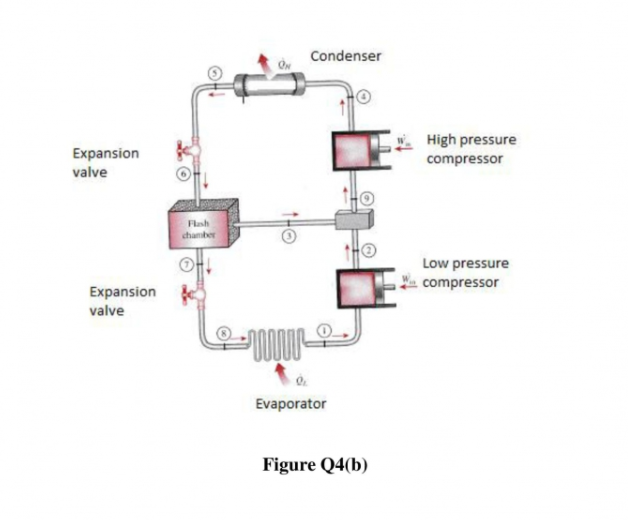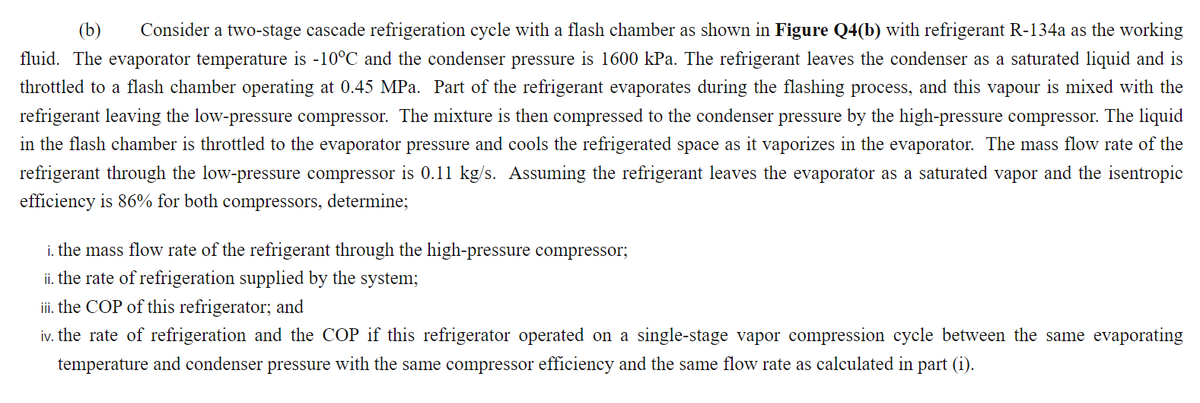Condenser High pressure Expansion valve compressor Flsh chamber Low pressure compressor Expansion valve Evaporator Figure Q4(b)
Condenser High pressure Expansion valve compressor Flsh chamber Low pressure compressor Expansion valve Evaporator Figure Q4(b)
Refrigeration and Air Conditioning Technology (MindTap Course List)
8th Edition
ISBN:9781305578296
Author:John Tomczyk, Eugene Silberstein, Bill Whitman, Bill Johnson
Publisher:John Tomczyk, Eugene Silberstein, Bill Whitman, Bill Johnson
Chapter22: Condensers
Section: Chapter Questions
Problem 7RQ: When a standard-efficiency air-cooled condenser is used, the condensing refrigerant will normally be...
Related questions
Question
subject (thermo 2)
pls show full steps with clear handwriting
pls answer me in 20 mins sir

Transcribed Image Text:Condenser
High pressure
Expansion
compressor
valve
Flash
chamber
Low pressure
compressor
Expansion
valve
Evaporator
Figure Q4(b)

Transcribed Image Text:(b)
Consider a two-stage cascade refrigeration cycle with a flash chamber as shown in Figure Q4(b) with refrigerant R-134a as the working
fluid. The evaporator temperature is -10°C and the condenser pressure is 1600 kPa. The refrigerant leaves the condenser as a saturated liquid and is
throttled to a flash chamber operating at 0.45 MPa. Part of the refrigerant evaporates during the flashing process, and this vapour is mixed with the
refrigerant leaving the low-pressure compressor. The mixture is then compressed to the condenser pressure by the high-pressure compressor. The liquid
in the flash chamber is throttled to the evaporator pressure and cools the refrigerated space as it vaporizes in the evaporator. The mass flow rate of the
refrigerant through the low-pressure compressor is 0.11 kg/s. Assuming the refrigerant leaves the evaporator as a saturated vapor and the isentropic
efficiency is 86% for both compressors, determine;
i. the mass flow rate of the refrigerant through the high-pressure compressor;
ii. the rate of refrigeration supplied by the system;
iii. the COP of this refrigerator; and
iv. the rate of refrigeration and the COP if this refrigerator operated on a single-stage vapor compression cycle between the same evaporating
temperature and condenser pressure with the same compressor efficiency and the same flow rate as calculated in part (i).
Expert Solution
Step by step
Solved in 10 steps with 11 images

Knowledge Booster
Learn more about
Need a deep-dive on the concept behind this application? Look no further. Learn more about this topic, mechanical-engineering and related others by exploring similar questions and additional content below.Recommended textbooks for you

Refrigeration and Air Conditioning Technology (Mi…
Mechanical Engineering
ISBN:
9781305578296
Author:
John Tomczyk, Eugene Silberstein, Bill Whitman, Bill Johnson
Publisher:
Cengage Learning

Refrigeration and Air Conditioning Technology (Mi…
Mechanical Engineering
ISBN:
9781305578296
Author:
John Tomczyk, Eugene Silberstein, Bill Whitman, Bill Johnson
Publisher:
Cengage Learning